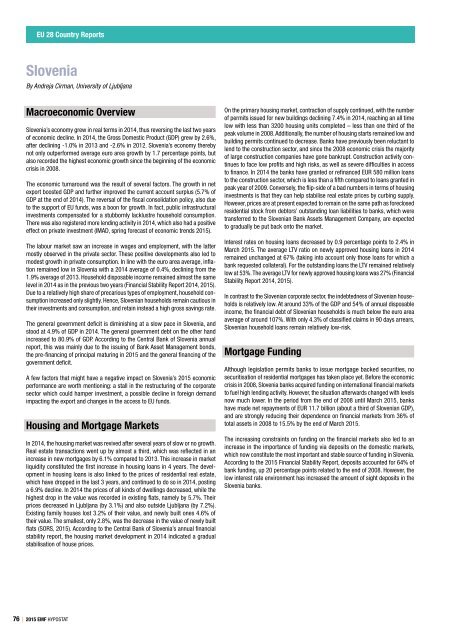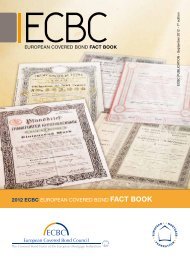Hypostat 2015
On 30 September 2015, the EMF-ECBC published Hypostat 2015 , which is its main statistical report, encompassing data on recent developments in housing and mortgage markets in the EU28 and beyond. Hypostat is the result of a collaborative effort by the European Mortgage Federation’s national delegations and external experts. The publication covers 33 countries – i.e. the EU28 plus Iceland, Norway, Russia, Turkey and the United States.
On 30 September 2015, the EMF-ECBC published Hypostat 2015 , which is its main statistical report, encompassing data on recent developments in housing and mortgage markets in the EU28 and beyond. Hypostat is the result of a collaborative effort by the European Mortgage Federation’s national delegations and external experts.
The publication covers 33 countries – i.e. the EU28 plus Iceland, Norway, Russia, Turkey and the United States.
Create successful ePaper yourself
Turn your PDF publications into a flip-book with our unique Google optimized e-Paper software.
EU 28 Country Reports<br />
Slovenia<br />
By Andreja Cirman, University of Ljubljana<br />
Macroeconomic Overview<br />
Slovenia’s economy grew in real terms in 2014, thus reversing the last two years<br />
of economic decline. In 2014, the Gross Domestic Product (GDP) grew by 2.6%,<br />
after declining -1.0% in 2013 and -2.6% in 2012. Slovenia’s economy thereby<br />
not only outperformed average euro area growth by 1.7 percentage points, but<br />
also recorded the highest economic growth since the beginning of the economic<br />
crisis in 2008.<br />
The economic turnaround was the result of several factors. The growth in net<br />
export boosted GDP and further improved the current account surplus (5.7% of<br />
GDP at the end of 2014). The reversal of the fiscal consolidation policy, also due<br />
to the support of EU funds, was a boon for growth. In fact, public infrastructural<br />
investments compensated for a stubbornly lacklustre household consumption.<br />
There was also registered more lending activity in 2014, which also had a positive<br />
effect on private investment (IMAD, spring forecast of economic trends <strong>2015</strong>).<br />
The labour market saw an increase in wages and employment, with the latter<br />
mostly observed in the private sector. These positive developments also led to<br />
modest growth in private consumption. In line with the euro area average, inflation<br />
remained low in Slovenia with a 2014 average of 0.4%, declining from the<br />
1.9% average of 2013. Household disposable income remained almost the same<br />
level in 2014 as in the previous two years (Financial Stability Report 2014, <strong>2015</strong>).<br />
Due to a relatively high share of precarious types of employment, household consumption<br />
increased only slightly. Hence, Slovenian households remain cautious in<br />
their investments and consumption, and retain instead a high gross savings rate.<br />
The general government deficit is diminishing at a slow pace in Slovenia, and<br />
stood at 4.9% of GDP in 2014. The general government debt on the other hand<br />
increased to 80.9% of GDP. According to the Central Bank of Slovenia annual<br />
report, this was mainly due to the issuing of Bank Asset Management bonds,<br />
the pre-financing of principal maturing in <strong>2015</strong> and the general financing of the<br />
government deficit.<br />
A few factors that might have a negative impact on Slovenia’s <strong>2015</strong> economic<br />
performance are worth mentioning: a stall in the restructuring of the corporate<br />
sector which could hamper investment, a possible decline in foreign demand<br />
impacting the export and changes in the access to EU funds.<br />
Housing and Mortgage Markets<br />
In 2014, the housing market was revived after several years of slow or no growth.<br />
Real estate transactions went up by almost a third, which was reflected in an<br />
increase in new mortgages by 6.1% compared to 2013. This increase in market<br />
liquidity constituted the first increase in housing loans in 4 years. The development<br />
in housing loans is also linked to the prices of residential real estate,<br />
which have dropped in the last 3 years, and continued to do so in 2014, posting<br />
a 6.9% decline. In 2014 the prices of all kinds of dwellings decreased, while the<br />
highest drop in the value was recorded in existing flats, namely by 5.7%. Their<br />
prices decreased in Ljubljana (by 3.1%) and also outside Ljubljana (by 7.2%).<br />
Existing family houses lost 3.2% of their value, and newly built ones 4.6% of<br />
their value. The smallest, only 2.8%, was the decrease in the value of newly built<br />
flats (SORS, <strong>2015</strong>). According to the Central Bank of Slovenia’s annual financial<br />
stability report, the housing market development in 2014 indicated a gradual<br />
stabilisation of house prices.<br />
On the primary housing market, contraction of supply continued, with the number<br />
of permits issued for new buildings declining 7.4% in 2014, reaching an all time<br />
low with less than 3200 housing units completed – less than one third of the<br />
peak volume in 2008. Additionally, the number of housing starts remained low and<br />
building permits continued to decrease. Banks have previously been reluctant to<br />
lend to the construction sector, and since the 2008 economic crisis the majority<br />
of large construction companies have gone bankrupt. Construction activity continues<br />
to face low profits and high risks, as well as severe difficulties in access<br />
to finance. In 2014 the banks have granted or refinanced EUR 580 million loans<br />
to the construction sector, which is less than a fifth compared to loans granted in<br />
peak year of 2009. Conversely, the flip-side of a bad numbers in terms of housing<br />
investments is that they can help stabilise real estate prices by curbing supply.<br />
However, prices are at present expected to remain on the same path as foreclosed<br />
residential stock from debtors’ outstanding loan liabilities to banks, which were<br />
transferred to the Slovenian Bank Assets Management Company, are expected<br />
to gradually be put back onto the market.<br />
Interest rates on housing loans decreased by 0.9 percentage points to 2.4% in<br />
March <strong>2015</strong>. The average LTV ratio on newly approved housing loans in 2014<br />
remained unchanged at 67% (taking into account only those loans for which a<br />
bank requested collateral). For the outstanding loans the LTV remained relatively<br />
low at 53%. The average LTV for newly approved housing loans was 27% (Financial<br />
Stability Report 2014, <strong>2015</strong>).<br />
In contrast to the Slovenian corporate sector, the indebtedness of Slovenian households<br />
is relatively low. At around 33% of the GDP and 54% of annual disposable<br />
income, the financial debt of Slovenian households is much below the euro area<br />
average of around 107%. With only 4.3% of classified claims in 90 days arrears,<br />
Slovenian household loans remain relatively low-risk.<br />
Mortgage Funding<br />
Although legislation permits banks to issue mortgage backed securities, no<br />
securitisation of residential mortgages has taken place yet. Before the economic<br />
crisis in 2008, Slovenia banks acquired funding on international financial markets<br />
to fuel high lending activity. However, the situation afterwards changed with levels<br />
now much lower. In the period from the end of 2008 until March <strong>2015</strong>, banks<br />
have made net repayments of EUR 11.7 billion (about a third of Slovenian GDP),<br />
and are strongly reducing their dependence on financial markets from 36% of<br />
total assets in 2008 to 15.5% by the end of March <strong>2015</strong>.<br />
The increasing constraints on funding on the financial markets also led to an<br />
increase in the importance of funding via deposits on the domestic markets,<br />
which now constitute the most important and stable source of funding in Slovenia.<br />
According to the <strong>2015</strong> Financial Stability Report, deposits accounted for 64% of<br />
bank funding, up 20 percentage points related to the end of 2008. However, the<br />
low interest rate environment has increased the amount of sight deposits in the<br />
Slovenia banks.<br />
76 | <strong>2015</strong> EMF HYPOSTAT



